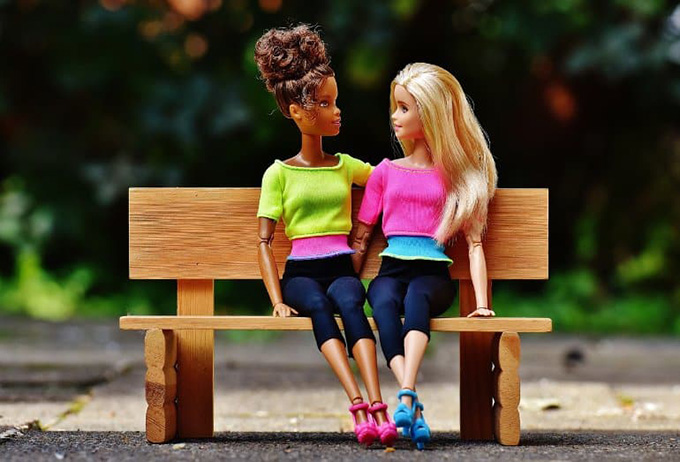
Dolls have been part of human cultures for millennia. The oldest that are known, in wood, date from the year 2000 BC . Fashion dolls are among the most popular children’s toys today , with Barbie being one of the best-selling models of all time.
However, some of these most popular fashion dolls have bodies so thin that they could never be achieved or maintained by a human being in real life.
We know that viewing images of thin women can alter viewers’ satisfaction with their appearance and reinforce the belief that thin bodies are “perfect” – this is called internalizing the thin ideal. . So should we be worried about the potential effects of ultra-thin dolls on children whose self-image is still in the making?
In a study published by the journal Body Image , my colleagues and I found evidence that ultra-thin dolls affect the body standards and ideals they set for themselves. Moreover, playing with more realistic-looking dolls afterwards does not correct for these effects – at least during the short periods of our study.
Late childhood and pre-adolescence are key stages in becoming aware of our own bodies and those of others, and it is during this period that girls begin to show prejudice against fat , internalize an ideal of thinness and to worry about their appearance .
Growing up with these influences could have a serious impact on their future mental and physical health. Being dissatisfied or dissatisfied with one’s body and internalizing an ideal of thinness contributes to the development of eating disorders , depression and lack of exercise .
Studies investigating the influence of ultra-thin dolls on young girls have had mixed results. Sometimes they showed that the girls who played with these dolls wished they had a slimmer body themselves . Other studies have not shown an effect on self-esteem, while nevertheless emphasizing that it caused the internalization of an ideal of thinness .
Playing with ultrathin dolls can also have socio-cultural and psychological implications. In one study, girls who played with these dolls—regardless of how the doll was dressed—seemed to imagine fewer career possibilities than those who played with toys that didn’t look human, or in boy bands. .
More or less realistic doll styles
Observing the need to deepen this subject, we conducted two experiments. The first was to find out what changed playing with ultra-thin dolls rather than more realistic-looking dolls like Dora and Lottie . The second was to determine whether the effects were reversed when the little girls subsequently played with these other, more “realistic” dolls or other toys.
It’s important to note that our studies included “benchmark tests”: we assessed children’s ideal body measurements before and after they played with the dolls. We asked the girls how they judged their own body, what their ideal body would be today and then in adulthood.
In the first experiment, 31 girls aged 5 to 9 played for five minutes with ultra-thin dolls or realistic dolls. We found that girls who played with ultra-thin dolls were less satisfied with their bodies and that the ideal bodies according to them were significantly thinner at the end of the session than at the beginning.
Those who had dolls with more realistic appearances were more satisfied with their own appearance and their definitions of the ideal body did not change. These results suggest that a short period of play with ultra-thin dolls can impact young girls’ ideals and well-being.
Representations internalized by the game
In our second experiment, we wanted to test whether playing with more realistic dolls or other toys like toy cars could offset the negative effects caused by playing with ultra-thin dolls.
As part of this experiment, 46 girls aged 5 to 10 participated in two three-minute play sessions. At the premiere, they all played with ultra-thin dolls. During the second, they either played with ultra-thin dolls again, or with more realistic dolls, or with cars sporting faces.
The results replicated one of the key findings from the first experiment. The participants’ ideal selves seemed to have slimmed down considerably after the first play session. plays.
This suggests that once a shift in preferences for a leaner body has begun, playing with more realistic dolls or other toys may not “fix” it immediately.
My colleagues and I have hypothesized that this apparent change in preferences may be the result of several psychological mechanisms. One of them is to internalize the positive messages that ultra-thin dolls create around their measurements. On the other hand, there are more “simple” effects of visual exposure, whereby our brain adapts to a new bodily “norm” based on what is perceived.
Previous research has shown that these two mechanisms can work together, suggesting that ultrathin dolls can act on representations of young girls by combining cultural and visual elements. Combined with previous research, these studies confirm the potential risk these fashion dolls pose to girls’ self-image.
If dolls aren’t the only source of influence that girls are exposed to – TV, movies, social media, their parents and peers also play an important role – reducing their overall exposure to biased images of a body ideal can help them form more positive representations.
Parents and educators can help young girls feel more comfortable with their image and teach them to love their bodies by modeling themselves as people who are calm about their appearances, but they can also think about toys. and the media they offer to their children.
Author Bio: Lynda Boothroyd is Professor in Psychology at Durham University